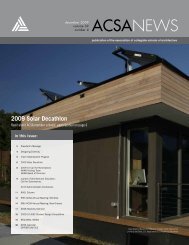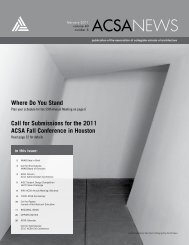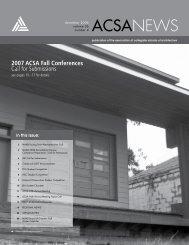digital aptitudes - Association of Collegiate Schools of Architecture
digital aptitudes - Association of Collegiate Schools of Architecture
digital aptitudes - Association of Collegiate Schools of Architecture
Create successful ePaper yourself
Turn your PDF publications into a flip-book with our unique Google optimized e-Paper software.
THURSDAY, MARCH 1, 2012 - 4:00PM - 5:30PM<br />
1912: Progress, Technology, and Nature<br />
Fran Leadon, City College <strong>of</strong> New York<br />
Utopias/Dystopias: From the Progressive Era to a<br />
Sustainable Future<br />
Marie-Alice L’Heureux, University <strong>of</strong> Kansas<br />
This paper characterizes the decades <strong>of</strong> the progressive era (1890-<br />
1920), their challenges, optimisms, and investments in infrastructure.<br />
From a succinct discussion <strong>of</strong> utopian and dystopian novels<br />
and their relevance to late 19th century cities, I then explore their<br />
relevance to the early progressive era from the 1893 Columbian<br />
exposition in Chicago to the 1901 Pan-American exposition in Buffalo,<br />
New York. I characterize the challenges for architects in this<br />
era when the focus was on urban-scaled engineering projects and<br />
architects were engaged in the expressive aspects <strong>of</strong> the urban environment<br />
that underscored their limitations in the rapidly changing<br />
technological realm. At the turn <strong>of</strong> the 21st century, architects<br />
again find themselves as a similar junction. Urbanized countries<br />
consume more energy and produce more greenhouse gases than<br />
un-urbanized ones, but within urbanized countries, dense urban<br />
centers consume as much as 30% less energy than the suburbs or<br />
rural areas. Cities are struggling to invest wisely in their urban infrastructure<br />
and are trying to re-create themselves as denser, more<br />
efficient centers <strong>of</strong> innovation and creativity. To engage in this discussion,<br />
architects and planners need to understand the deep historic<br />
roots associated with these challenges and to prioritize the<br />
intersection <strong>of</strong> the human aspects <strong>of</strong> design with the more familiar<br />
aesthetic and technological issues <strong>of</strong> design.<br />
From Orthographic to Eccentric: Tall <strong>Architecture</strong> <strong>of</strong><br />
Extremes<br />
Terri Boake, University <strong>of</strong> Waterloo<br />
Height has long served as a benchmark for progress as it relates to<br />
the built manifestation <strong>of</strong> advancements in engineering and architectural<br />
technology. The past 100 years are marked by major advances<br />
in the construction <strong>of</strong> tall buildings. This paper will look at<br />
the architectural ramifications <strong>of</strong> changes in the structural form <strong>of</strong><br />
tall buildings. Building references will span early framing systems<br />
such as those used in the Woolworth Building to more eccentric<br />
diagrid systems. The impact <strong>of</strong> the destruction <strong>of</strong> the World Trade<br />
Towers will be examined for its impact on current practices in the<br />
design <strong>of</strong> SuperTall buildings. The material nature <strong>of</strong> the structural<br />
system, the emergence <strong>of</strong> wind engineering and questions <strong>of</strong> redundancy<br />
in design will also be included.<br />
The On-Again Off-Again Romance Between Nature<br />
and Technology in Healthcare Settings<br />
Mardelle Shepley, Texas A&M University<br />
The purpose <strong>of</strong> this paper is to describe the relative influence and<br />
dominance <strong>of</strong> technology and nature in the development <strong>of</strong> healthcare<br />
facilities in recent history. The history <strong>of</strong> healthcare design<br />
over the last 100 years can be segmented into four eras that are<br />
characterized by different attitudes towards technology and nature:<br />
the progressive era, the modernist era, the era <strong>of</strong> scientific<br />
humanism, and the era <strong>of</strong> evidence-based design. The Progressive<br />
era began in the mid-1850s and is associated with the Nightingale<br />
prototype. Among the design objectives <strong>of</strong> the period were the<br />
pervasiveness <strong>of</strong> natural light and ventilation. Hospitals <strong>of</strong> the Modernist<br />
era were <strong>of</strong>ten rendered in the International Style. These<br />
hospitals evolved into large, block buildings with minimal daylight<br />
in the central areas due to the deep floor plate. The era <strong>of</strong> Scientific<br />
Humanism was a reaction to the technological emphasis <strong>of</strong> the previous<br />
epoch. Designers during this period attempted to produce<br />
environments that were s<strong>of</strong>ter, and more residential in character.<br />
Our current hospital epoch, the Evidence-based Design era, uses<br />
science to inform the architecture <strong>of</strong> healing environments and describe<br />
the impact <strong>of</strong> nature. Although many hospitals in the United<br />
States still reflect the modernist vernacular <strong>of</strong> deep floor plates<br />
and long, double-loaded corridors, most new hospitals have been<br />
significantly influenced by Evidence-based Design.<br />
If nature and technology are the primary predictors <strong>of</strong> the future <strong>of</strong><br />
health care design, their on-again, <strong>of</strong>f-again relationship in healthcare<br />
settings may be self-resolving. Our simultaneous desire for<br />
the most advanced technology and the most untainted nature are<br />
intensifying. This approach is currently expressed in the form <strong>of</strong><br />
technological sustainability and biophilic healing, concepts that<br />
will likely be the hallmark <strong>of</strong> healthcare design in developed countries<br />
for the next half century.<br />
Evaluating Progressivism: A Critique <strong>of</strong> Biomimetic<br />
<strong>Architecture</strong><br />
Wynn Buzzell, University <strong>of</strong> North Carolina at Charlotte<br />
The following discourse considers biomimicry as a progressive<br />
trend, and aims to examine its validity and relevance, particularly<br />
as it relates to architecture. Establishment <strong>of</strong> validity is accomplished<br />
through examination <strong>of</strong> its historical context, definition <strong>of</strong><br />
its typologies and methodologies, taxonomic categorization <strong>of</strong> its<br />
terminology, a discussion <strong>of</strong> its contemporary portrayal, and provision<br />
<strong>of</strong> a series <strong>of</strong> illustrative examples to augment the observations<br />
<strong>of</strong>fered. These observations, characterizations, and conclusions,<br />
will be discussed through conceptual consideration <strong>of</strong> how<br />
“second nature” and humanities innate biophilic tendencies have<br />
given rise to biomimetic architectural methodologies. Particular<br />
attention is given to the concept <strong>of</strong> “second nature” and related<br />
ideas which deal with mankind’s perception <strong>of</strong> its connectedness<br />
to nature. This connectedness is discussed as it relates to the ways<br />
humankind imitates nature. Conclusions aim to define and clarify<br />
the semantics, typologies and methodologies <strong>of</strong> biomimicry.<br />
Digital Apptitutes + Other Openings - Boston, MA - 11








